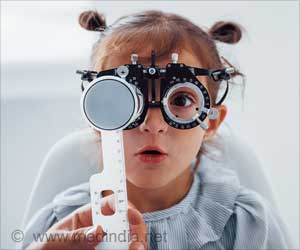
There’s no shortage of possible worries. Near-sightedness, far-sightedness and unexpected mishaps can create problems. As a child’s eyes and vision develop, parents must help protect and care for them. But when is the right time to see a doctor? And how often should you schedule appointments?
How Often Should I Take My Child to the Eye Doctor?
From birth, children receive regular vision screenings that are different from the full eye exams conducted by ophthalmologists and optometrists. Vision screenings are routinely performed by pediatricians and school nurses. For example, they can conduct red reflex examinations in very young children, where the pediatrician uses a tool to shine a light into the child’s eye to screen for any serious ocular diseases that could impair visual development, such as a cataract.
Advertisement
Another method used by both pediatricians and school nurses as kids get a bit older are photoscreeners. A special camera takes a picture of the eye’s light reflexes, which the instrument analyzes to screen conditions such as refractive error, which indicates a need for glasses, and strabismus, also known as crossed or lazy eye. If the instrument identifies a problem, the child is referred to an eye doctor for a complete eye examination.
Once children are old enough to read an eye chart, that provides the most reliable method of screening. This type of screening takes place at well-child visits and at school.
“So not all children need a complete eye examination,” Soni said. “If there are no vision concerns for a child, most children do not need routine eye care.”
A caveat: a child should receive regular eye examinations if they have a family history of childhood-onset eye problems or if the child has a systemic condition, such as Down syndrome or diabetes.
What are Some Common Eye Problems among Children?
Refractive errors such as nearsightedness, farsightedness and astigmatism are the most common conditions. Parents might notice nearsightedness if a child always gets up close or squints their eyes to see things far away.
Another common eye condition in children is the previously mentioned strabismus. “If a child’s eyes don’t seem to be lining up when making eye contact with you, then that is something that should be checked out,” Soni said.
Eye contact in babies typically develops around eight weeks, so parents should not worry about inconsistent eye contact during those early weeks, Soni said.
“Similarly, during those first weeks, the baby’s eyes can be intermittently crossing or drifting out,” he said. “That’s pretty typical.”
READ RELATED: Food study that turns understanding of snacking on its head: Claims ice cream is better than granola
While the red reflex is usually detected during an examination by a pediatrician, sometimes parents notice it when taking a picture, even though most phone cameras now have red-eye blockers. If you see a red reflex that is consistently asymmetric ― seeing it only in one eye, or noticing the reflex is different colors in each eye ― that may indicate a problem. This effect might also be noticed when the child is sitting in front of a lighted window.
It’s possible those unequal reflections are an indication of the presence of a cataract or, in rare cases, a tumor. “Such a child warrants a complete eye examination by an eye doctor,” Soni said.
Parents should also take note of any redness, tearing or light sensitivity. These could be signs of inflammation or infection in a child’s eyes.
What is the Best Way to Protect a Child’s Eyes from Injury?
When it comes to potential eye injuries, sports present the biggest risk. Parents should consider the use of protective goggles.
Children also need to be educated about the proper use and safety of household objects like scissors, pencils and wire coat hangers. Bungee cords and Nerf guns can potentially cause serious eye injuries.
While many parents are concerned about the effect that digital screens have on their child’s eyesight, there’s no evidence that electronic devices are harmful to the eyes, Soni said. However, the blue light from screens interferes with the brain’s release of melatonin at bedtime, and that’s why parents should consider limiting their child’s use of electronic devices at the end of the day. “That goes for children and adults,” Soni said.
Prolonged “near work” of any type, like looking at electronic devices or reading books, can, however, increase the risk of developing nearsightedness. To mitigate the risk, Soni suggests following the 20-20-20 rule: after every 20 minutes of near work, look up at something 20 feet away (such as a tree out the window) for 20 seconds to give your eye muscles time to relax.
Time spent playing outdoors can help keep your child’s eyes healthy and is protective against the development of nearsightedness.
Source: Newswise
Source:







